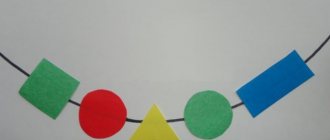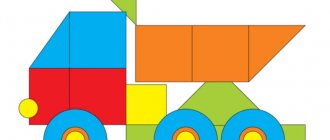Tasks:
Formation of a positive attitude towards nature in children.
To form knowledge and develop children’s skills in caring for natural objects.
To instill in children the motive for socially significant work.
Improve children's labor skills and abilities.
Materials for the lesson: oilcloth, aprons, disposable cups for each child, a stick, a watering can with water, a box or bucket of soil, scoops, jars with cuttings in water for each child, the teacher has several indoor plants (Geranium), from which cuttings are taken .
Progress of the lesson
Introductory conversation with children about indoor plants. • What plants do you know in this corner of nature? (Children name several plants.) • Why are they called indoor plants? (These are plants that in our area do not grow in the open ground all year round, because they do not tolerate cold winters.) Surprise moment: A knock is heard on the door, the postman comes in and brings a beautiful box. The teacher explains that in order to find out what is in the box and open it, you need to guess the riddle: Riddle. Round leaves, Lush flowers, Even very good - That’s what the kids decided. On the window so early... (geranium) blossomed.
Educator: Each flower is beautiful in its own way. Geranium is a symbol of warmth and comfort, a symbol of a home where you are always welcome. It’s not for nothing that geranium is called “grandmother’s flower.” “Granny” means dear, familiar, homely... The flower was born far, far away in South Africa. Travelers and seafarers brought it to us. Everyone liked it because it blooms so beautifully. Let's take a closer look at geranium (pelargonium). This plant is light-loving, it has a straight stem, rounded, light green leaves on long cuttings. Brown, brownish circles seem to be drawn on the leaves. Flowers grow in a “bouquet” - an inflorescence.
Planting a cutting. Educator: Guys, who wants to plant a geranium cutting and then give such a beautiful plant to their mother? (Children speak out.) How to plant cuttings? (Teacher demonstration.)
Make a hole with a stick, stick it into the ground and scroll.
Place the cutting in a hole in the ground.
Press the soil near the cuttings, but not too close to the stem.
Water the planted cuttings.
Independent work activity. Planting cuttings by children. Children count the number of leaves and remember. When a new leaf appears, the cutting has taken root and is growing. Water the plant.
Outcome of the lesson: Talk with children about caring for plants. Remind them that the children will bring these plants as a gift to their mother.
Children working outdoors
Children's hard work in the open air
Good feelings have their roots in childhood, and humanity, kindness, dignity, goodwill are born in work, worries, and worries about the beauty of the world around us.
V.A. Sukhomlinsky.
The work of preschool children in nature has its own specifics:
Final goal
is remote in time and requires long-term physical and mental effort from the child, as well as daily painstaking work. For example, to grow vegetables, berries, flowers, etc., the results of labor are concrete and understandable to the child, but they cannot be achieved quickly, as is the case in manual labor (if you made some kind of toy, you can play).
Involves the participation and assistance of an adult.
The content of children's work in nature in each age group.
In each age group, the types and content of children’s labor activity and the tasks that are solved in the process of child labor are determined.
Preschool children
At about age, children are taught to carry out the simplest instructions for adults: with the help of a teacher, sow large flower seeds, plant onions, water plants in the beds, and collect vegetables.
In the middle group
children carry out work assignments independently; together with adults, they grow vegetables and flowers on the site (when digging, they clear the ground of stones and sticks, systematically water the beds, flower beds, loosen the soil, and collect vegetables). At the same time, children are taught perseverance and the habit of making labor efforts to achieve a goal, as well as the skills of simple team work. Children of this age must be gradually prepared to understand that for plants to live and grow, it is necessary to create favorable conditions (certain soil, sunlight, heat, moisture, etc.).
Senior preschoolers (5-7 years old)
it is necessary to learn to work in all seasons:
In the fall, on their plot, children can harvest vegetables, collect seeds, dig up plant bulbs, rake leaves, take part in transplanting plants from the ground into a corner of nature, digging ridges and flower beds, and planting trees and shrubs.
In winter, remove snow from paths and feed wintering birds.
In the spring, dig up, loosen the soil, make beds and flower beds, sow large and small seeds, care for plants in the garden, in the garden, in the flower garden. Loosen the soil, water, thin out, weed, tie up plants, harvest - in the summer. Know how to properly use a shovel, scoop, rake, and watering can.
Organization of work of preschool children.
Child labor should be measured.
The duration of the labor process depends on the nature of the work, the age and capabilities of the child. For example, when sowing seeds, the size of the planting material and sowing technique are taken into account; when weeding, children are required to concentrate and pay great attention.



